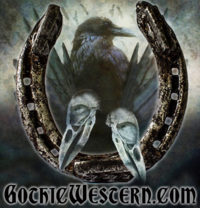In the history of Western hats it is known that the earliest cowboys were young rejects from Europe who decided to keep traveling west after they reached New York, or soldiers who had just mustered out of the military and had nowhere else to go. Their hats and outfits were the items they brought with them. They wore a combination of tams, various military hats (even sailor) and formal top hats. Rakes chased out west by someone’s husband probably were the ones who wore the top hats.
 However, things changed in 1865. Legend says (and since this legend has been around for over one hundred years, it is now undisputed truth) that John B. Stetson, the son of a Philadelphia hat maker, came out west for his health. During a break in a hunting trip John Stetson decided to show off his hat making skills. He shaved some of the soft fur off the animals they had taken during their trip, got it wet and pliable by dipping it in boiling water, and kneaded it until he had created a smooth piece of felt. – When manipulated in warm water, the thousands of strands of under-fur from certain animals interlock together to create a strong, smooth fabric. Again, according to legend, he dug a hole in the ground to use as a mold for the hat. As a joke – probably through the encouragement of strong spirits, which seem to be standard equipment in many hunt camps – Stetson made the hat with an extra large crown and brim. Legend goes on to say that one of the cowboys in camp was so impressed with the hat that he bought it on the spot for five dollars, or that Stetson wore the hat throughout the west until a cowboy bought it later. Whichever story is true, the bottom line is that when Stetson sold that hat he realized he had come up with a product that met a need.
However, things changed in 1865. Legend says (and since this legend has been around for over one hundred years, it is now undisputed truth) that John B. Stetson, the son of a Philadelphia hat maker, came out west for his health. During a break in a hunting trip John Stetson decided to show off his hat making skills. He shaved some of the soft fur off the animals they had taken during their trip, got it wet and pliable by dipping it in boiling water, and kneaded it until he had created a smooth piece of felt. – When manipulated in warm water, the thousands of strands of under-fur from certain animals interlock together to create a strong, smooth fabric. Again, according to legend, he dug a hole in the ground to use as a mold for the hat. As a joke – probably through the encouragement of strong spirits, which seem to be standard equipment in many hunt camps – Stetson made the hat with an extra large crown and brim. Legend goes on to say that one of the cowboys in camp was so impressed with the hat that he bought it on the spot for five dollars, or that Stetson wore the hat throughout the west until a cowboy bought it later. Whichever story is true, the bottom line is that when Stetson sold that hat he realized he had come up with a product that met a need.
Stetson’s hat protected the wearer from the burning sun and pouring rain. It was waterproof enough to be used to water his horse; it was strong enough to fan a fire; the crown was tall enough to be used as a hiding place for money or valuable documents (hence the phrase “keep it under your hat”); it was so large that a cowboy could signal to a friend at a distance; and most important, correctly styled, it told everyone the wearer was a dandy. It is said that for the early cowboy, his hat was the first item of clothing he put on in the morning and the last item he took off at night. These cowboys often called their hats a “sombrero,” the same as the Spanish Caballeros. They also called them a “conk-cover,” “lid” or “war bonnet.” It was not long before they were known as “Stetsons” or “John B’s.” John B. Stetson simply called them “the Boss of the Plains.”
Stetson’s hat had the ability to be shaped to fit the individual’s own taste. Over a period of time, similar to today’s fashions, cowboys in different areas started wearing their hats styled alike. This was in part because they wanted to look like their buddies (Although they were individualists, they also had a tendency to conform.). Cowboys on some large ranches actually developed their own style. Local environmental differences also dictated different hat styles. When Texas cowboys took cattle up north they found the strong winds got caught underneath the wide brims of their hats and sent them flying. Necessity required the wide brims of the Southwest that protected the wearer from the sun be replaced with Northwestern style narrow brims that survived the wind. A well-traveled person could tell where a cowboy came from by the shape and style of his hat.
(to be continued…)



